Main menu
Common skin conditions

NEWS
Join DermNet PRO
Read more
Quick links
Brachioradial pruritus — extra information
Brachioradial pruritus
Authors: Dr Amanda Oakley, Dermatologist, New Zealand, 2002. Updated: Dr Annabelle Yi Zhang, Auckland City Hospital, New Zealand; Honorary Associate Professor Paul Jarrett, Dermatologist, Middlemore Hospital and Department of Medicine, The University of Auckland, Auckland, New Zealand. Copy edited by Gus Mitchell. March 2021
Introduction
Demographics
Causes
Clinical features
Complications
Diagnosis
Differential diagnoses
Treatment
Outcome
z## What is brachioradial pruritus?
Brachioradial pruritus is a localised form of neuropathic cutaneous dysaesthesia on one or both upper limbs. The presentation is usually an itch without rash; however, scratching and rubbing can result in secondary skin changes.
Secondary skin changes on the forearm of brachioradial pruritus
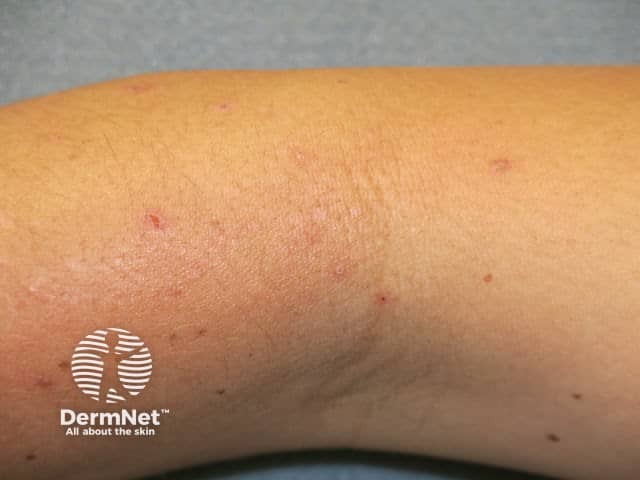
Lichenification from scratching
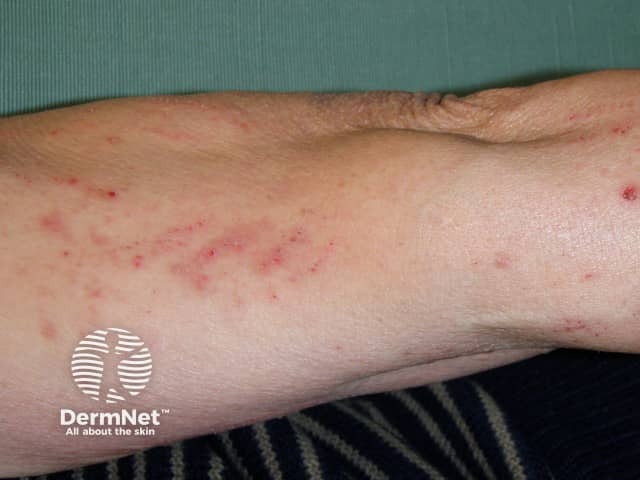
Excoriations
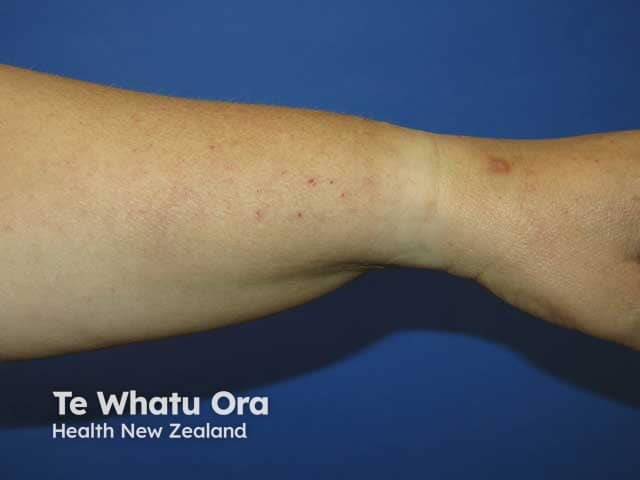
Excoriations
Who gets brachioradial pruritus?
Brachioradial pruritus can affect both sexes, all skin types, and age groups ranging from early teenage years through to the elderly, but is typically seen in fair-skinned women in late middle-age.
What causes brachioradial pruritus?
Brachioradial pruritus is likely to be multifactorial in origin. There are two current theories to explain brachioradial pruritus:
- UV radiation damage to C fibres that transmit itch; supported by the predominance in fair-skinned patients with 50% reporting worsening of symptoms in summer, and improvement in symptoms with sun protection, however it does not explain the localised focal often unilateral involvement, and sparing of the face yet involvement of the trunk.
- Cervical spine abnormalities — including foramen stenosis, spurs, cervical rib(s), cervical disc herniation, or metastatic cancer; supported by neuropathic symptoms and signs, involvement of the C5-6 dermatomes, and improvement with treatment directed at the cervical spine pathology.
What are the clinical features of brachioradial pruritus?
Brachioradial pruritus presents as itch without rash, most commonly on the proximal forearm in the C6 distribution overlying the brachioradial muscle. It may be unilateral or bilateral, and may extend to adjacent dermatomes or skin sites, such as the shoulders, back, and chest.
- Secondary changes due to scratching and rubbing may include excoriations, ecchymoses, lichenification, and nodular prurigo.
- Neurological symptoms and signs include burning, tingling, or stinging; altered sensation with pinprick, cotton wool, heat or cold; absent or reduced sweating.
- Ice pack sign — patients report application of an ice pack alleviates symptoms.
Secondary skin changes due to brachioradial pruritus
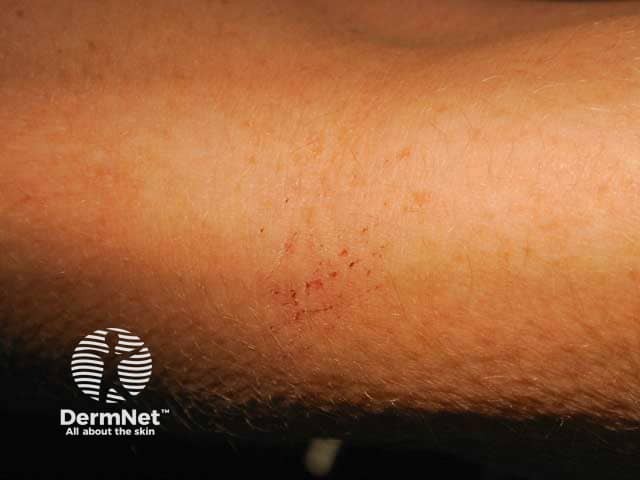
Brachioradial pruritus, forearm early excoriations
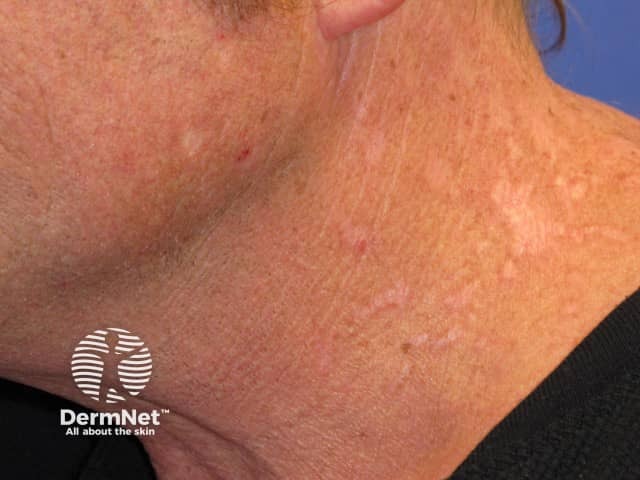
Brachioradial pruritus, scarring on the neck

Brachioradial pruritus, upper limb secondary skin lichenification
What are the complications of brachioradial pruritus?
- Psychological distress and reduced quality of life
- Generalisation of itch.
How is brachioradial pruritus diagnosed?
Brachioradial pruritus is a clinical diagnosis based on history and examination.
Cervical spine imaging (X-ray, MRI) should be considered particularly in patients with neurological symptoms/signs and/or a lack of seasonal variation.
What is the differential diagnosis for brachioradial pruritus?
What is the treatment for brachioradial pruritus?
General measures
Specific measures
- Clinically significant cervical pathology may require specific intervention
- Physiotherapy, cervical spine manipulation
- CT-guided cervical nerve root block or steroid injections
- Surgery
- Amitriptyline
- Gabapentin
- Capsaicin.
What is the outcome for brachioradial pruritus?
- There is no consensus on the most effective treatment with few randomised controlled trials, and mostly small case series or single case reports.
- It can be difficult to achieve sustained symptom resolution.
- Repeated courses of treatment may be required for recurrence of symptoms.
Bibliography
- Binder A, Fölster-Holst R, Sahan G, et al. A case of neuropathic brachioradial pruritus caused by cervical disc herniation. Nat Clin Pract Neurol. 2008;4(6):338–42. doi:10.1038/ncpneuro0807. PubMed
- Cohen AD, Masalha R, Medvedovsky E, Vardy DA. Brachioradial pruritus: a symptom of neuropathy. J Am Acad Dermatol. 2003;48(6):825–8. doi:10.1067/mjd.2003.494. PubMed
- Kwatra SG, Stander S, Bernhard JD, Weisshaar E, Yosipovitch G. Brachioradial pruritus: a trigger for generalization of itch. J Am Acad Dermatol. 2013;68(5):870–3. doi:10.1016/j.jaad.2012.11.026. PubMed
- Marziniak M, Phan NQ, Raap U, et al. Brachioradial pruritus as a result of cervical spine pathology: the results of a magnetic resonance tomography study. J Am Acad Dermatol. 2011;65(4):756–62. doi:10.1016/j.jaad.2010.07.036. PubMed
- Mirzoyev SA, Davis MD. Brachioradial pruritus: Mayo Clinic experience over the past decade. Br J Dermatol. 2013;169(5):1007–15. doi:10.1111/bjd.12483. Journal
- Pham C, Cox S, Smith J. Brachioradial pruritus in a patient with metastatic breast cancer to her cervical spine. JAAD Case Rep. 2020;6(7):619–21. doi:10.1016/j.jdcr.2020.04.034. PubMed Central
- Tait CP, Grigg E, Quirk CJ. Brachioradial pruritus and cervical spine manipulation. Australas J Dermatol. 1998;39(3):168–70. doi:10.1111/j.1440-0960.1998.tb01274.x. PubMed
- Veien NK, Laurberg G. Brachioradial pruritus: a follow-up of 76 patients. Acta Derm Venereol. 2011;91(2):183–5. doi:10.2340/00015555-1006. Journal
- Wallengren J. Brachioradial pruritus: a recurrent solar dermopathy. J Am Acad Dermatol. 1998;39(5 Pt 1):803–6. doi:10.1016/s0190-9622(98)70058-1. PubMed
- Weinberg BD, Amans M, Deviren S, Berger T, Shah V. Brachioradial pruritus treated with computed tomography-guided cervical nerve root block: a case series. JAAD Case Rep. 2018;4(7):640–4. doi:10.1016/j.jdcr.2018.03.025. PubMed Central
On DermNet
- Compulsive skin picking
- Cutaneous dysaesthesia
- Meralgia paraesthetica
- Notalgia paraesthetica
- Pruritus
Other websites
- Brachioradial pruritus — Medscape
- Brachioradial pruritus — ACD A-Z of Skin
